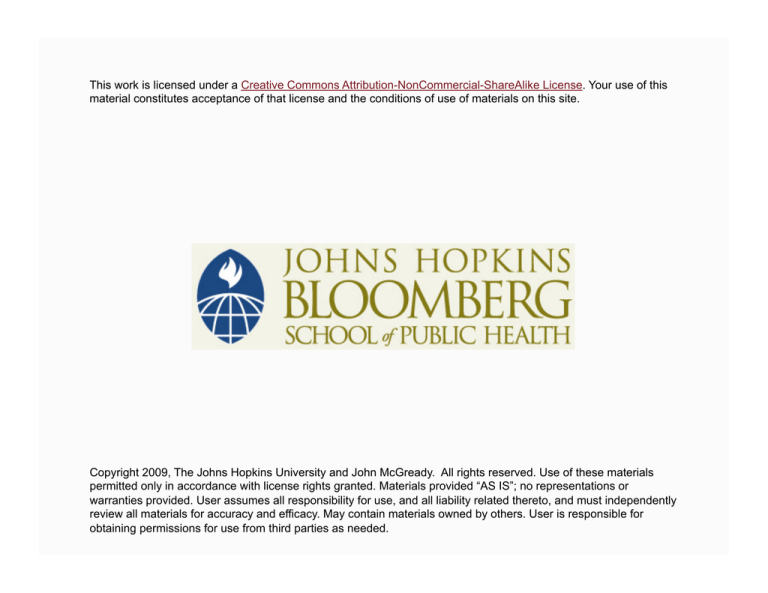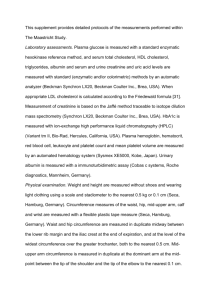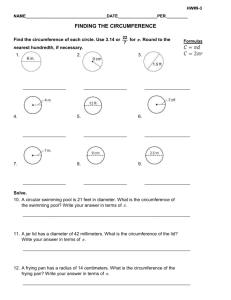
This work is licensed under a Creative Commons Attribution-NonCommercial-ShareAlike License. Your use of this
material constitutes acceptance of that license and the conditions of use of materials on this site.
Copyright 2009, The Johns Hopkins University and John McGready. All rights reserved. Use of these materials
permitted only in accordance with license rights granted. Materials provided “AS IS”; no representations or
warranties provided. User assumes all responsibility for use, and all liability related thereto, and must independently
review all materials for accuracy and efficacy. May contain materials owned by others. User is responsible for
obtaining permissions for use from third parties as needed.
Relating a Continuous Outcome to More than One
Predictor: Multiple Linear Regression
John McGready
Johns Hopkins University
Lecture Topics
Why multiple linear regression?
Interpreting coefficients from multiple linear regression
Statistical inference on multiple regression coefficients
ANOVA as a linear regression model
Statistical interaction and linear regression
3
Section A
Why (Multiple) Linear Regression?
Multiple Linear Regression
Recall the arm circumference examples from lecture 4
At the end of the analysis, we found a positive statistically
significant association between arm circumference and height
- With SLR, we estimated the magnitude of this association
(slope) and put 95% confidence limits on it
- We also estimated that child height explained 46% of the
variability in arm circumference
At the end of the analysis, we found a negative, but non-statistically
significant association between arm circumference and female sex
5
Questions
Let’s start by expanding on the SLR model that included only height
as a predictor
6
Questions
Is it possible that other factors, besides child height, explain
variability in arm circumference as well (for example, child weight)
- Can any of these other factors explain some of the variability
not explained by height?
Is it possible that the relationship between arm circumference and
height is different after accounting for weight or sex differences by
height
7
Arm Circumference and Weight
SLR model that includes only weight (kg) as a predictor
Relationship is positive, statistically significant
The R2 is .70 indicating that weight explains an estimated 70% of the
variability in arm circumference
8
Questions
How can we estimate the relationship between arm circumference
and both weight and height in the same analysis?
Answer: multiple linear regression
We can estimate an equation of the following type:
-
Where x1 is height (cm) and x2 is weight (kg)
9
Arm Circumference and Weight
MLR model that includes both weight and height as a predictor
10
Results
This model is given by:
Together, height and weight explain an estimated 76% of the
variability in arm circumference
Both height and weight are statistically significant predictors of arm
circumference in this model
How to interpret in the estimated relationship between arm
circumference and the height (
) and weight (
predictors in an MLR model that includes both?
)
11
Slope of Height in MLR of Arm Circ on Height, Weight
The slope estimate for height is
- Still there is an estimated mean difference in arm
circumference between two groups who differ by one cm in
height, but are of the same weight
- This is called the weight-adjusted association between arm
circumference and height
- This result estimates that groups of children who differ by 1 cm
in height but are the same weight will differ in arm
circumference on average by -0.16 cm, taller to shorter
- If we were to compare two groups of children of the same
weight, but who differ by 1 cm in height, the taller group would
have arm circumference reduced by 0.16 on average
The 95% for the true height-adjusted arm circumference and weight
association is -0.21 to -0.11
12
Recapping the Results
So far we have results from three models: arm circumference on
height, arm circumference on weight, and arm circumference on
height and weight
Unadjusted
SLR1: x = height
Height
SLR2: x = weight
0.16 (0.13-0.19)
Weight
R2
Unadjusted
0.46
Adjusted
MLR: x1 = height, x2 = weight
-0.16 (-0.21, -0.11)
0.80 (0.72 - 0.89)
1.40 (1.20, 1.40)
0.70
0.76
13
Arm Circumference and Weight
MLR model that includes weight, height, and child sex as predictors
(sex = 1 for females)
14
Arm Circumference and Weight
Interesting: the unadjusted (crude) relationship between arm
circumference and sex showed a negative, but non-statistically
significant association between arm circumference and female sex
After adjusting for both height and weight, the association between
arm circumference and being female is positive, and statistically
significant
- Female children have arm circumferences of 0.30 cm greater on
average when compared to male children of the same height
and weight (95% CI:0.07 cm to 0.53 cm)
15
Arm Circumference and Weight
MLR model that includes weight, height, and child sex as predictors
(sex = 1 for females)
16
Arm Circumference and Weight
Can also use results of this MLR for estimating mean arm
circumferences for children given height, weight, and sex
Here:
is estimated mean arm circumference, x1 = height (cm),
x2 = weight (kg), x3 = sex (1 = female)
17






